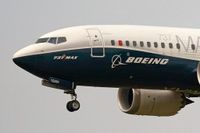The Federal Aviation Administration (FAA) has proposed a $3.1 million fine against Boeing, intensifying scrutiny over the aerospace giant’s safety and manufacturing practices. The penalty, announced on September 13, 2025, comes after a series of safety violations between September 2023 and February 2024, including a harrowing incident in January 2024 when a door plug panel blew out midflight on an Alaska Airlines Boeing 737 Max 9 shortly after departing from Portland, Oregon.
The January 2024 event could have ended in tragedy. The aircraft, carrying 171 passengers and six crew members, experienced a sudden loss of a paneled-over exit door—known as a door plug—just minutes after takeoff. Miraculously, no one was seriously injured, and the pilots managed to land the plane safely back at Portland International Airport. According to KATU and Newsweek, passengers on board described moments of sheer terror as air pressure dropped inside the cabin, but quick action by the crew averted disaster.
The FAA’s proposed fine covers not only this incident but also a broader range of violations uncovered during the same period. As reported by NPR and Boston Herald, the agency identified “hundreds of quality system violations” at Boeing’s 737 factory in Renton, Washington, as well as at Spirit AeroSystems’ 737 factory in Wichita, Kansas—a key subcontractor for Boeing. The FAA’s findings included a particularly troubling episode: a Boeing employee pressured a member of the company’s Organization Designation Authorization (ODA) unit to approve a 737 Max airplane for delivery, despite the ODA member’s determination that the aircraft did not comply with applicable standards. The FAA alleges this was done to help Boeing meet its delivery schedule, raising serious questions about the independence of safety checks within the company.
In June 2025, the National Transportation Safety Board (NTSB) concluded its own 17-month investigation into the Alaska Airlines door plug blowout. The NTSB’s findings, cited by The Associated Press and Newsweek, were damning: lapses in Boeing’s manufacturing and safety oversight, combined with ineffective FAA inspections and audits, directly contributed to the incident. The NTSB’s report echoed long-standing concerns from lawmakers and aviation safety advocates, who have repeatedly called for stricter oversight of Boeing since the 737 Max’s return to service.
The FAA’s press release, quoted by Newsweek, stated: “The FAA identified hundreds of quality system violations at Boeing’s 737 factory in Renton, Washington, and Boeing subcontractor Spirit AeroSystems’ 737 factory in Wichita, Kansas. Additionally, Boeing presented two unairworthy aircraft to the FAA for airworthiness certificates and failed to follow its quality system.”
Boeing, based in Arlington, Virginia, now has 30 days to respond to the FAA’s proposed fine. The company’s reply could lead to settlement negotiations, an administrative hearing, or a final agency order, depending on the FAA’s enforcement process. In a statement to KATU and Newsweek, a Boeing spokesperson said, “We regret the January 2024 door-plug accident and continue to work on strengthening our safety culture and improving first-time quality and accountability across our operations.” The spokesperson added, “Last year, under the oversight of the FAA, we instituted a Safety & Quality Plan with key performance indicators to enhance safety management and quality assurance in airplane production. Our team continues to implement these improvements, such as investing in workforce training, strengthening production system compliance and encouraging employees to speak up.”
This is hardly the first time Boeing’s 737 Max has come under the spotlight for safety concerns. The Max line has been dogged by controversy since two deadly crashes in 2018 and 2019—in Indonesia and Ethiopia—that killed a combined 346 people. Those disasters led to a worldwide grounding of the 737 Max fleet and prompted a wave of investigations, lawsuits, and regulatory reforms. In May 2025, the U.S. Justice Department reached a deal allowing Boeing to avoid criminal prosecution for allegedly misleading regulators about the Max before those crashes, as reported by NPR.
The latest proposed fine signals that federal authorities remain deeply concerned about Boeing’s safety culture and quality control. The FAA’s action could have ripple effects, influencing everything from certification timelines to production rates and even supply-chain reviews for Boeing-built planes. As Newsweek notes, the move is seen as a continuation of federal intervention in aircraft production oversight, reflecting persistent worries about whether Boeing has truly addressed the systemic issues that have haunted its recent history.
Adding to Boeing’s woes, the company has faced other high-profile incidents in recent months. In June 2025, a Boeing 787 operated by Air India crashed shortly after takeoff, killing at least 270 people. While investigators have not yet determined the cause of that crash, they have so far found no flaws with the 787 model itself, which has generally maintained a strong safety record. Still, the string of incidents has kept Boeing under a harsh spotlight and fueled debate over the effectiveness of both internal and external oversight mechanisms.
The FAA’s findings have also reignited calls from lawmakers and safety advocates for tougher regulation of the aerospace industry. Many have argued that the current system, which allows manufacturers like Boeing to delegate some certification responsibilities to internal ODA units, is ripe for conflicts of interest and undue pressure. The alleged interference by a Boeing employee in the ODA approval process, as highlighted by the FAA, is likely to become a focal point in ongoing discussions about regulatory reform.
Despite the turbulence, Boeing is publicly committing to change. The company says it is reviewing the proposed civil penalty and remains focused on improving its safety management systems, workforce training, and culture of accountability. Whether these efforts will be enough to satisfy regulators, lawmakers, and—most importantly—the flying public, remains to be seen.
For now, the FAA’s $3.1 million fine stands as a stark reminder that, in the world of aviation, safety lapses carry consequences. As Boeing faces its latest reckoning, the eyes of the industry—and of travelers everywhere—will be watching closely to see what happens next.


